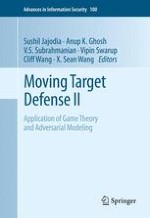2013 | OriginalPaper | Buchkapitel
8. Diversifying the Software Stack Using Randomized NOP Insertion
verfasst von : Todd Jackson, Andrei Homescu, Stephen Crane, Per Larsen, Stefan Brunthaler, Michael Franz
Erschienen in: Moving Target Defense II
Verlag: Springer New York
Aktivieren Sie unsere intelligente Suche, um passende Fachinhalte oder Patente zu finden.
Wählen Sie Textabschnitte aus um mit Künstlicher Intelligenz passenden Patente zu finden. powered by
Markieren Sie Textabschnitte, um KI-gestützt weitere passende Inhalte zu finden. powered by
